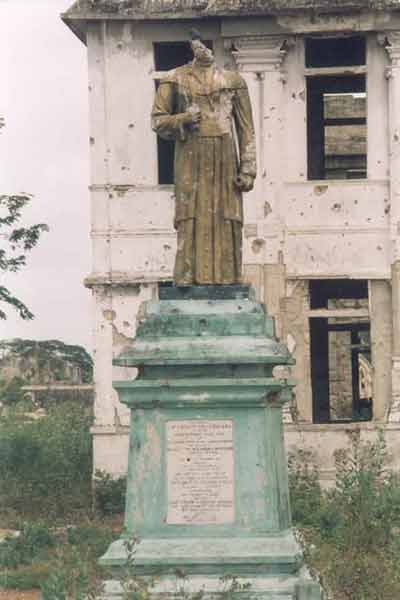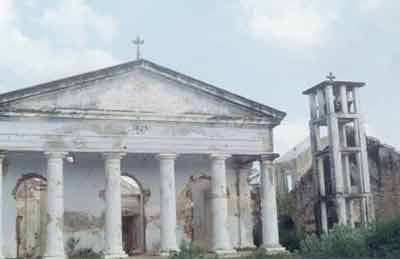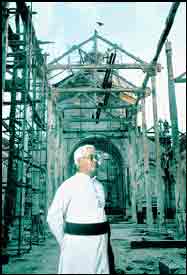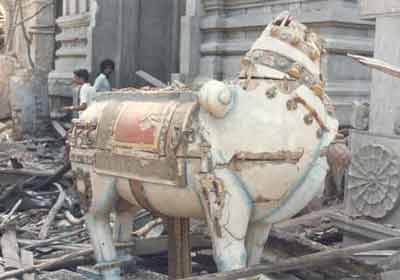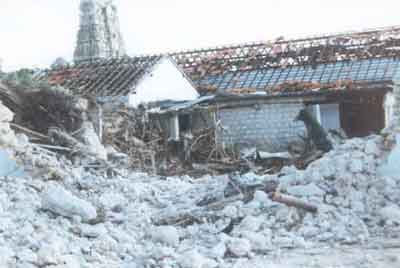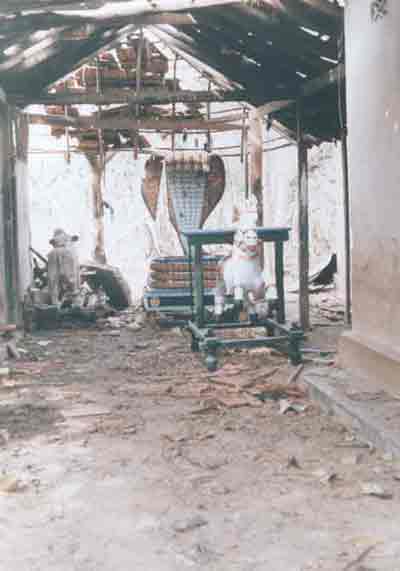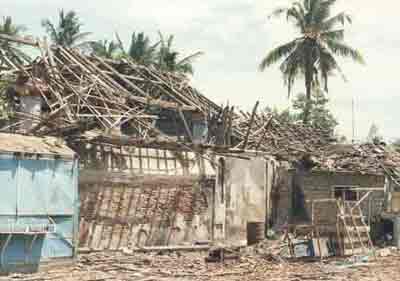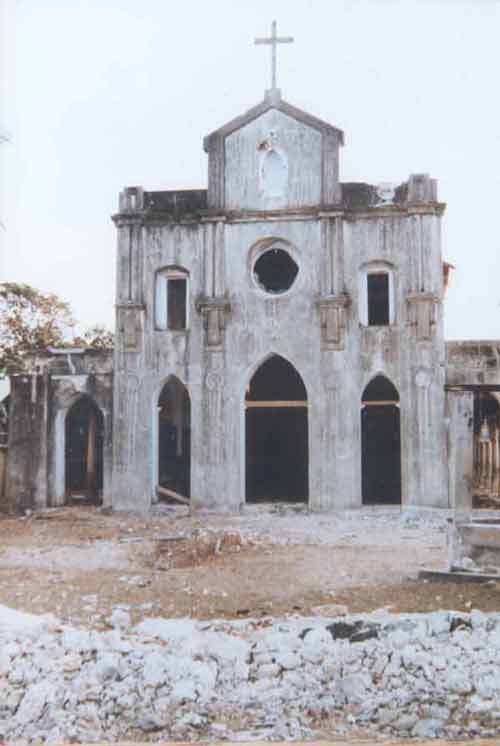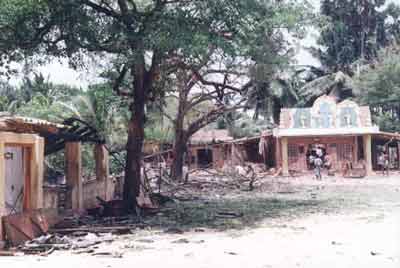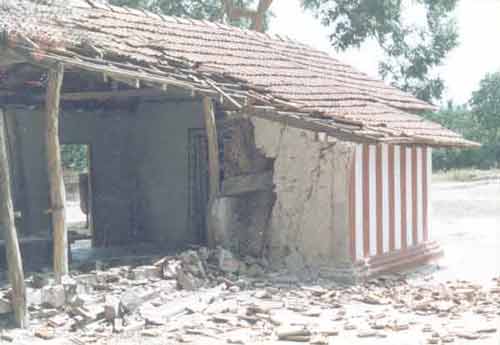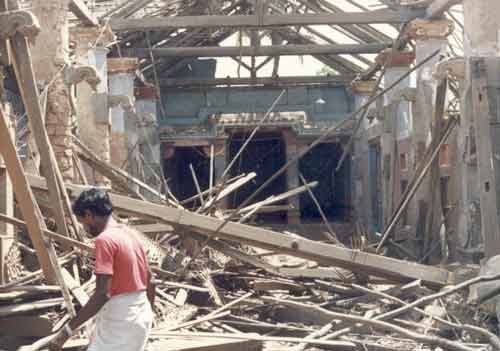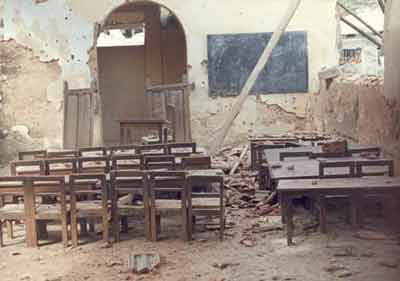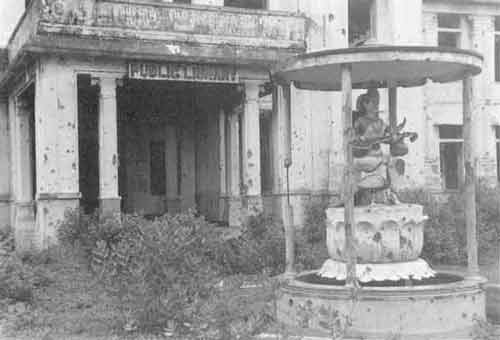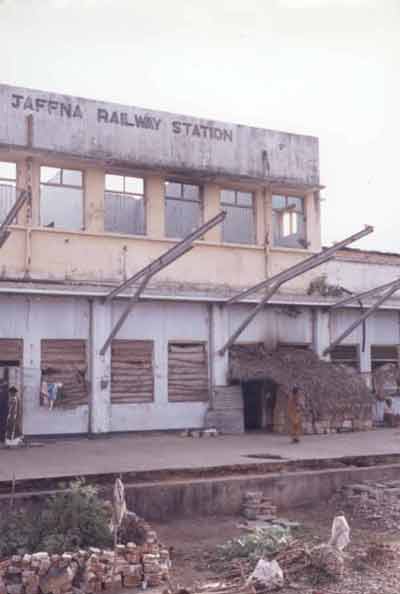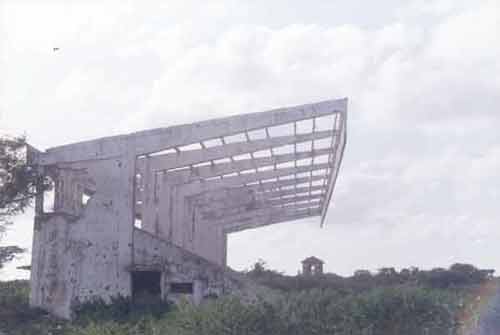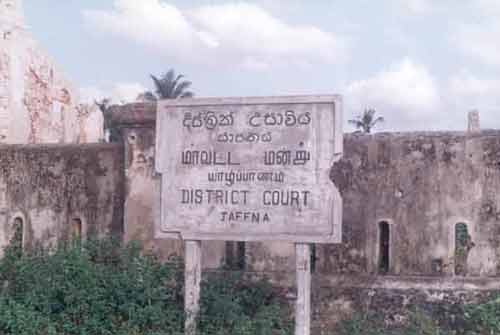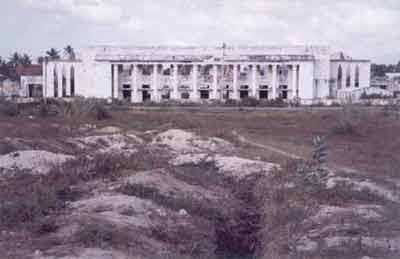| Taliban and the Sinhala Buddhists
(Click on photos to see larger image) |
||
|
At an NGO sponsored meeting in New York last year, a Sri Lankan woman got up to interrupt. She was angry at the LTTE, and by extension at all Tamils in general. She spoke fervently about the attack on the most-sacred Buddhist temple of the tooth (Dalada Maligawa), and then added something intriguing – “We (Sinhalese) have never attacked even ‘one-single’ Hindu temple!” With this there was a hushed silence in the room, and then someone muttered – “it is really not true.” The climate of denial under which Sri Lankans are living is truly remarkable. As far as most Sri Lankans are concerned, the horror of the war in the northeast of that island simply doesn’t exist. The effects of wars in other far-away places, which they see on their televisions, are far more real and hideous than what goes on in their own backyard. All they see and hear about their own country are evils of the LTTE and the heroism of the Sinhala soldiers! Now, with the Taliban actions against the Buddhist relics in Afghanistan, this ‘life-in-denial’ has been taken to another level. The Taliban destruction of the Buddhist statutes in Afghanistan is wicked. There can be no question on this. What the Taliban destroyed are secular symbols of human heritage. These are irreplaceable legacies of the collective history of all mankind. It is a tragedy, one that the whole world needs to face up to and deal with. It is not a matter for only the Buddhists to protest. Concerned as we are about this problem, this article is not about the Taliban. It is about Sri Lanka. Let he who has not sinned... Leave that young lady in New York alone. She, in a sense, is also a victim of the Sri Lankan government policies on its war with the Tamils. Her problem is one of ignorance - spawned and promoted by a purposeful NEWS BLOCKADE. In Sri Lanka today (and, for several years now), there is a strict ‘prohibition’ on media persons visiting the ‘war zones’ in the northeast (one never sees a CNN or a BBC news footage from there). Additionally, there is a government-imposed ‘censorship’ on publication of all ‘war related stories’, backed-up with intimidation and murder of journalists. On top of this, the media being either government-controlled or Sinhala-owned practice ‘self-censorship’, for obvious reasons. This three-tiered NEWS BLOCKADE on the war is total. The lady in New York really doesn’t know, and (with this media blackout) has no way of knowing, what her government is actually doing to the Tamils in the northeast Sri Lanka. Neither do most Sri Lankans. What about the two cabinet ministers? It is hard to believe that cabinet ministers in Sri Lanka do not know what goes on in the country they govern. They get information from briefings, internal memos and all sorts of other inside sources. In addition they also have access to the numerous, public and private, reports by outsiders. For example, at the March 1998 UNCHR hearing in Geneva, Joaquin Mbomio of North-South XXI, while condemning the attack on the Dalada Maligawa, stated, “some 1,800 Hindu temples have been destroyed by Sri Lanka’s military.” The ministers might not know the exact number of temples destroyed by their army, but surely must be aware that the number runs in the hundreds. Benefit of the doubt. “President Jayawardene of Sri Lanka claimed yesterday that his army withheld information from him on massacres that had been committed in the northern region of Jaffna... Leading members of the Tamil community in Jaffna have told the Guardian that in one incident, troops killed a number of students waiting at a bus stop… Lawyers in Jaffna claimed that the town’s magistrate was ordered by the Ministry of Defence in Colombo not to hold a planned inquest... Asked yesterday, why no inquests had been held, President Jayawardene said: ‘I didn’t know until a couple of days ago. It is too late now[!]’ [The Guardian, 8th August 1983] So, there is a small likelihood that these cabinet ministers just didn’t know about the systematic destruction of the non-Buddhist places of worship in their backyard. Otherwise, they wouldn’t be going around complaining about the Taliban with a straight face. Would they? Sangam Research, as a group of civic-minded ex-Sri Lankans, feel that it is incumbent upon us to alert these two cabinet ministers, so that they don’t make a fool of themselves, appearing hypocritical to the international community. Some of these folks in the ‘international community’, after all, are aware of what the Sri Lankan armed forces are doing in the northeast Sri Lanka. We could have written to these two ministers privately, but then there is the lady in New York, and the millions of Sinhalese like her, who are also in the dark about this. Hence this publication. Reports. It must be mentioned that it was not easy getting these photographs – Photographic Film, believe it or not, is a war-related banned item in the Sri Lankan embargo on Tamil homelands. Joaquin Mbomio said in Geneva, the number of Hindu temples destroyed thus far stood at around 1,800 in 1998. Fifteen years earlier, in one (1983) pogrom alone forty-six temples were either damaged or destroyed by the Sinhalese [see list below]. In 1982, the Jaffna based weekly Saturday Review, whose editor (Mr. S. Sivanayagam) was run out of the country by President Jayewardene, reported: “Kuranthan Malai, a quiet peaceful spot in Tamil-populated Mullaitivu with ruins of both Hindu and Buddhist places of worship, will soon house an exclusive Buddhist vihare and temple and a Sinhala settlement, according to plans drawn up by officials working under the Ministry of Industries and Scientific Affairs. Army personnel, an ex-Director of a Public Corporation under the Ministry who was also a leading member of the UNP Trade Union - the Jathika Sevaka Sangamaya - several Ceramics Corporation vehicles, and employees of the government Tile Factory of Oddichuddan 20 miles away - have all been enlisted in the implementation of this project. Hindu statues found in the site have been taken away in Army vehicles, according to the local villagers, as far back as November last year [1981]. Kurunthan Malai situated in the Nagancholai Forest Reserve has long been held in veneration by the Vanni Tamils as the dwelling place of the guardian deity, Kurandoor Aiyanar. The building of a Buddhist vihare at the site began several months ago, and some employees of the Tile Factory have been engaged in this, with orders apparently to do it unobtrusively without attracting public attention to the building activity. Following this, some local inhabitants had put up a hut and installed a “Choolam” (Hindu trident) on the spot, but Army personnel from the Mullaitivu camp had demolished the hut, thrown away the “Choolam”, chased away some of the Tamil families in the area and had taken away some of the youths in the area for questioning. Since then, a new road has been built through the Nagancholai Forest Reserve, to facilitate accessibility to this site from Oddichuddan. Three major consequences flow from this move, quite apparently initiated by the Ministry of Industries: (1) Archaeological sites are being damaged irrevocably, preventing any genuine archaeological research on them in the future; (2) Tamils who have lived in the area for generations are being displaced by new Sinhala colonists; (3) Hindu religious sites are being furtively desecrated thus preventing identification of such sites in the future…” Saturday Review [20 March 1982] This report is typical of hundreds of others on what has been going on in the entire northeast for the last several decades. The Prime Minister and the Foreign Minister may not have read this particular report or the others, and may even dismiss them as whimpers of a provincial newspaper. But, what would they say to the joint statement of 21 international NGOs in 1995, at the UNCHR hearings in Geneva? These twenty-one NGOs said: “Under the pretence of a military operation against the LTTE, the Sri Lanka government launched an intensive bombing and shell attack directed at Tamil civilian population centres in the Jaffna peninsula… Highflying supersonic jets indiscriminately bombed villages and also targeted temples, places of worship and schools where villagers had sought refuge from the incessant shelling. A large number of houses and hard earned belongings have been destroyed. These aerial bombardments follow a pattern set by the Sri Lanka armed forces over the past several years. St. Peters Church and St. Peters School in Navaly, at a great distance away from the line of battle and where hundreds had sought shelter, were deliberately bombed. More than 120 died including 13 babies in their mother’s arms… It appears that President Chandrika Kumaratunga’s government has intensified its attacks on the Tamil people with impunity, seemingly confident that there will be no international protest or outcry.” United Nations Commission for Human Rights
Hearing May be, these two ministers haven’t heard about this report either. What about the Gazette notification by which all temple lands belonging to the historic Keerimalai Naguleswarar temple and the Maviddapuram Kandaswamy temple were acquired for the expansion of the Palaly army base? [Sri Lanka Government Gazette Extraordinary; No.1083/9 of June 8, 1999] Shouldn’t these two gentlemen be aware of an official government edict under the seal of their own President?
Representations to the government. Year after year they made representations to the President(s) about this reckless destruction of their places of worship, schools, hospitals, other public buildings and their homes. In 1993, three religious dignitaries, Bishop D.J.Ambalavanar, Bishop Thomas Saundranayagam and Nallai Thiru Sampandar Atheenam, in a joint statement (17 November 1993), said: ‘‘We religious leaders from the North, belonging to the Hindu, Christian and Catholic religions... strongly protest against the actions of the Sri Lankan Air Force which seems guided by the sole motive of revenge and striking terror among the Tamil people.’’ ‘‘Following on the recent Pooneryn operations, the Air Force has used its supersonic bombers to bomb the Jaffna Secretariat killing and injuring several… It has bombed a place of worship, the St. James Catholic Church in Main Street, Jaffna destroying that large and venerated house of God and killing and injuring several innocent citizens. It has dropped its bombs within the protected zone around the Jaffna General Hospital damaging the hospital and striking panic among the patients and the public. We have reports that the hospitals in Killinochchi and Mulaitivu have also been bombed. The market block in Chavakachcheri has also been bombed and destroyed. All these buildings used exclusively for sacred worship and public services are such large and prominent structures that no Air Force can pretend innocence about the targets being struck... These events are not just sporadic occurrences but have been repeated so often in the past that we cannot but conclude it is part of state policy against the Tamils…” From time immemorial, even before the arrival of Buddhism in Sri Lanka, there have been five temples of Lord Siva, referred to as the Five-Iswarams, on the island. Three are in the northeast, and the Sri Lankan army is camped on the inside premises of all three of these temples, desecrating them on a daily basis. The Sinhalese are angry with the LTTE and the Tamils for the hits against two Buddhist sites. Two as opposed to eighteen hundred non-Buddhist ones! As they say in America, ‘For God’s Sake, Get Real!’ Enough said. If the ministers really didn’t know, and want more information on the places of worship destroyed by their armed forces, they can find it. Before they go complaining about the Taliban, however, they must first get their own house in order.
|
||
The 1983 Pogrom – List of Temples damaged/destroyed1. Viswanatha Sivan Temple in Trincomalee 2. Krishnan Temple in Trincomalee 3. Saneeswaran Temple in Trincomalee 4. Natesar Temple in Sivayogapuram, Trincomalee 5. Sri Tillaiambala Pillaiyar Temple in Anbuvalipuram, Trincomalee 6. Chithivinayakar Temple in Sinnatoduvai, Trincomalee 7. Vilankulam Pillaiyar Temple on Kandy Road, Trincomalee 8. Vyrutru Pillaiyar Temple on Kandy Road, Trincomalee 9. Pillaiyar Temple in China Bay, Trincomalee 10. Upparu Pillaiyar Temple in Trincomalee 11. Kitulootra Pallaiyar Temple in Kanniyai, Trincomalee 12. Kitulootra Murugan Temple in Trincomalee 13. Barathipuram Pillaiyar Temple in Pankulam, Trincomalee 14. Pillaiyar Temple in Pankulam, Trincomalee 15. Mudalikulam Pillaiyar Temple in Pankulam, Trincomalee 16. Ellai Kali Kovil in Pankulam, Trincomalee 17. Pillaiyar Temple in Panmadawachchi, Trincomalee 18. Papanasa Teertapillaiyar Temple in Trincomalee 19. Sri Pathini Amman Temple in Neelapalai, Kilivetti 20. Sri Kamakshi Ambal Temple in Jaffna 21. Saiva Maha Sabha in Kurunegala 22. Udupi Sri Muthuvinayakar Temple in Matale 23. Sri Muthumari Amman Temple in Matale 24. Muthuvinayakar Temple in Matale 25. Sri Chithivinayakar Temple in Matale 26. Sri Kadiresan Temple in Matale 27. Sri Poobalakrishnar Ashram in Matale 28. Sri Ganga Vinayakar Temple in Madulkelle 29. Kurinji Kumaran Temple, Peradeniya 30. Sri Muthumariamman Temple in Nawalapitya 31. Atmajothy Nilayam in Nawalapitiya 32. Athivinayakar Temple in Haldumulla, Haputale 33. Sri Sivasubramanya Temple in Bandarawela 34. Sri Kadiresan Temple in Badulla 35. Hindu Temple in Malangama, Badulla 36. Hindu Temple in Narangala, Badulla 37. Kali Temple in Rockhill, Badulla 38. Sri Poobalavinayakar Temple in Peliyagoda 39. Sri Balaselvavinayakar Temple in Maradana, Colombo 40. Sri Devi Karumari Amman Temple in Maligawatte, Colombo 41. Venkateswara Mahavishnu Moorthy Temple in Dehiwala, Colombo 42. Srimath Arunachaleswara Devasthanam in Colombo 43. Ramakrishna Mission, Colombo 44. Kandasamy Temple in Panadura 45. Sri Subramanya Temple in Matara 46. Hindu Pilgrims’ Rest in Matara |
||
|
SANGAM RESEARCH [22 MARCH 2000] |
||
